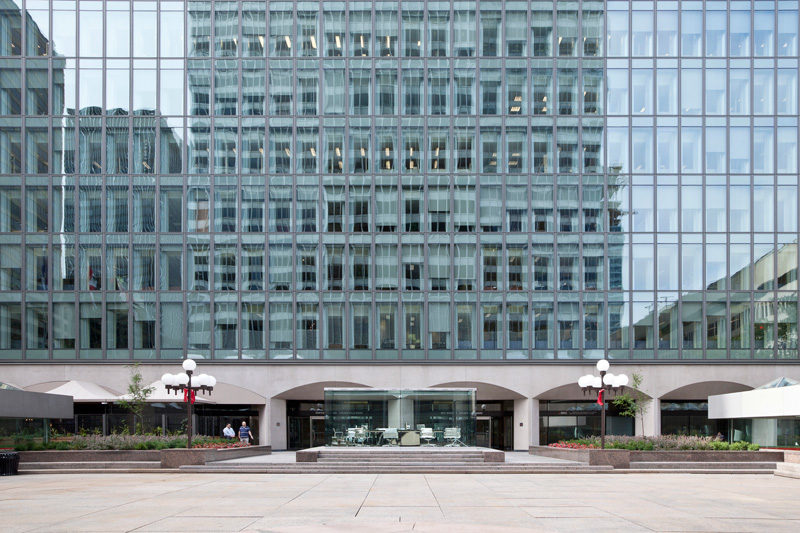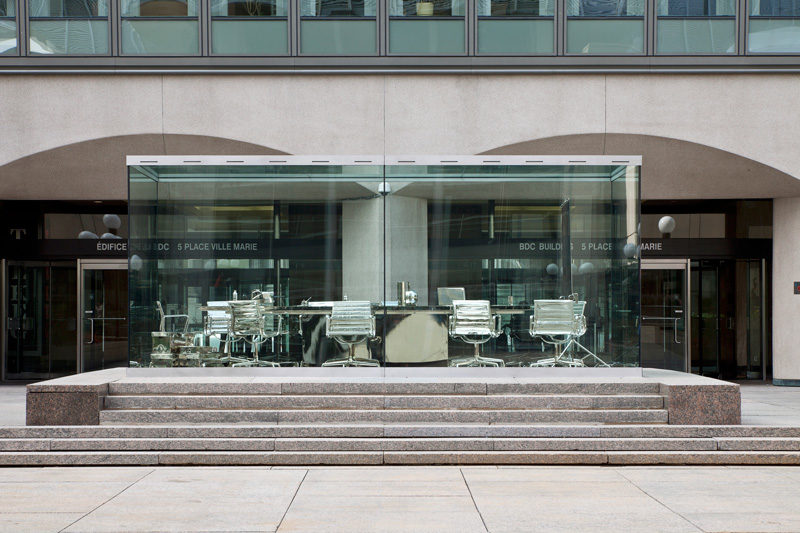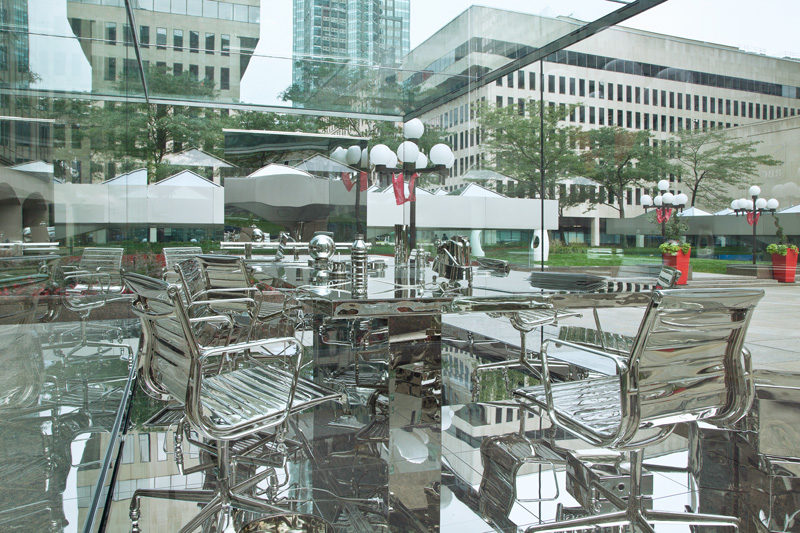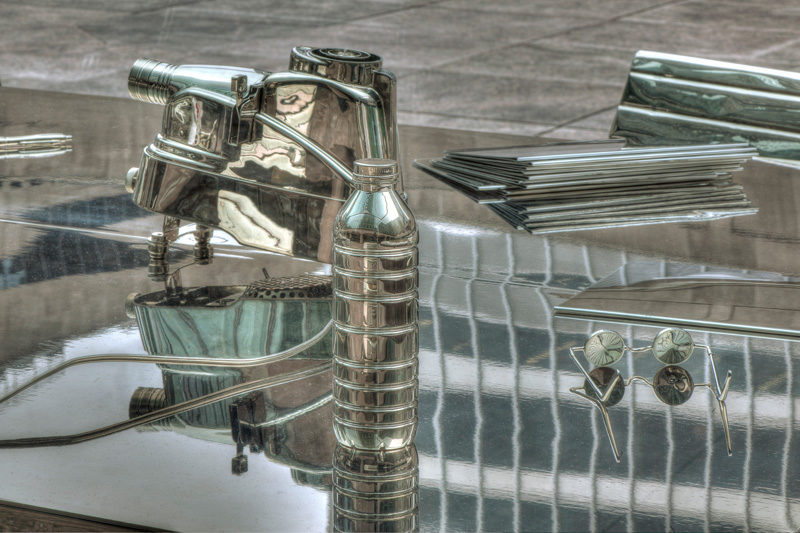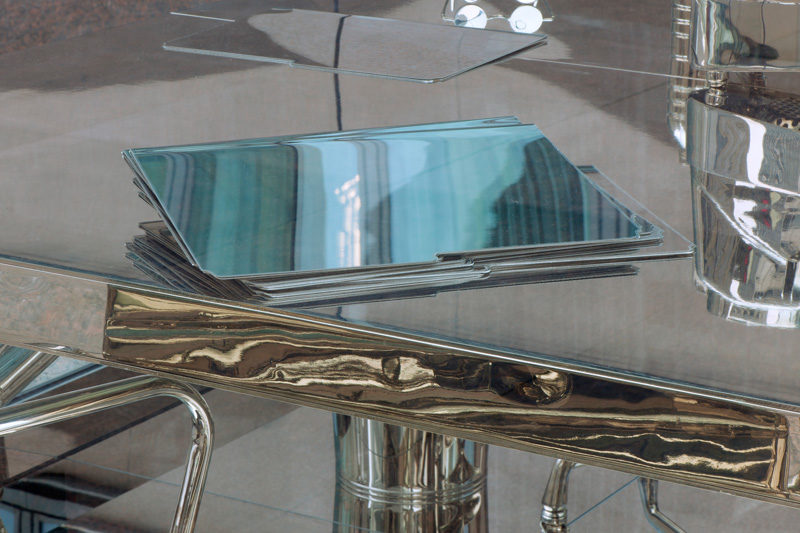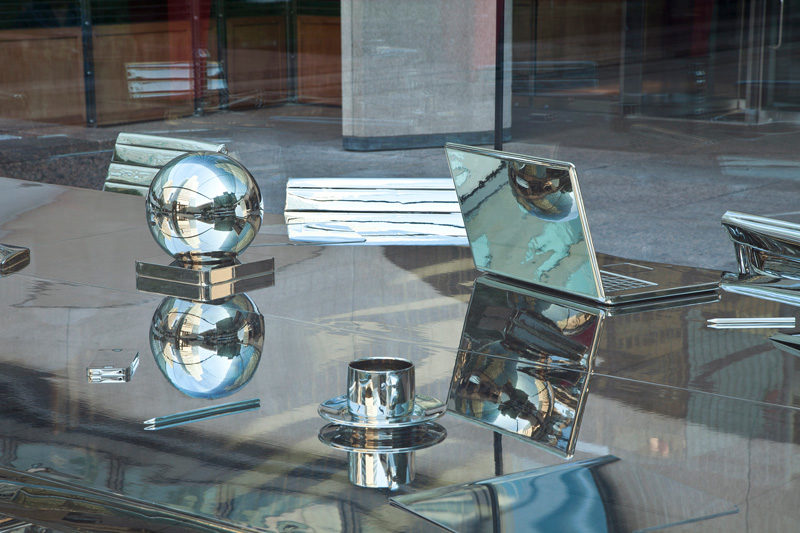[Spring-Summer 2013]
by Sylvain Campeau
To judge by his works, Nicolas Baier has never been anything but a photographer, as these works are replete with all the potentialities, components, and mechanisms of the medium. This is so even when the works he creates are not photographic. Of course, he provided abundant proof in his exhibitions Travaux récents (2001) and Scènes de genre (2003). Pareidolias, presented in 2010, was similar in nature. It was so, however, in a way that was like no other, as his works become other media by means of photography. For instance, the waste paper and detritus of Garage and Profils (2009) and of Vieux Continents (2007), the saturation of rooms in Chemin de l’eau and La formation des nuages (both 2008), and the oversized and disruptive pixels of Nourriture-Vaisselle (2001) are ways of exploring and exploding the mechanics and materials that make up photography. Of course, one might cite Damisch’s A Theory of /Clouds/ or speak of Rorschach-like shapes or Leonardo da Vinci’s Treatise on Painting, in which he sees the traces of landscapes in the simple shapes of stains and other nebulous formations. But we should recall that the pieces in Paesines, for example, are digitized pictures, closest to the original material, reproduced in their entirety, of mineral formations whose elementary composition is the same as that of the mineral originally used in silver-salts photography. Behind this picture-taking strategy, in the folds of the thing shown, photography looms like a ghost.1 This strict respect for scale evokes the idea of the foundation of the creation of the medium, which was to offer a completely faithful copy of the thing shown. The irony here is that it is in strictly obeying this modality that the work created no longer seems to have anything to do with photography.
The nature of the photographs’ belonging to the medium is the same in the various pieces of Vanitas, digital snapshots of silvered mirrors with damaged surfaces, printed life size and arranged in a mosaic that forms the work without revealing too clearly the reference upon which its structure is based. One might object that although the medium used is photography, the result is overtly pictorial in terms of both the final rendering and the iconographic and theoretical references. That’s true, but the mirror is an essential element of the mechanism and the thought that went into the invention of photography. In fact, before photography, copyists used the camera obscura, which, like the camera, was composed of a mirror. It is certainly astounding to note that the final result of this picture-taking, through the arrangement of the images, thwarts the photographic in favour of the pictorial and deviates the mirror object from its essential operation since it can thus, now, reflect nothing. The photographic operation that went into the creation of the final work disappears under its definitive rendering, as the pictorial aspect drowns out, so to speak, the photographic.
And Baier’s most recent work of public art is no different. Self-portrait – a title that is both revealing and apparently enigmatic – was created to celebrate the fiftieth anniversary of Place Ville-Marie. Situated in the gap between the many neighbouring towers, overlooking a light esplanade, the work is under glass – or, rather, the enclosure is a fundamental component of it. In this closed space, composed of non-reflective tempered glass, is a working environment that looks like a conference room all the elements of which are made of aluminium or steel then plated with shiny nickel, forming an attractive all-metal setting. It’s all there, from the screen on which the presentation planned for the occasion will be projected – as one imagines must occur in this type of space – to the projector, cups, pitchers and glasses of water, open or half-closed portable computers, rectangular table, and chairs. Everything is so metallic that the scene is almost unseen, disappearing behind the various reflections on its surfaces of the built-up environs facing the quadrilateral. This, no doubt, is when we understand the wisdom of the title: Self-portrait. In effect, the work offers, and as more than a title, a self-portrait of the place where it is installed. It does this through its materials but also through its very form, which reproduces an environment that one might easily find if one went to visit the occupied offices in these towers. It is, one might say, a perfect match for what is around it. It is also an analogon2, a reproduction, on a smaller scale, of a portion of the neighbouring offices. It refers to them. Like a photograph, it signals the real thing, of which it offers a reproduction, taking itself for that reproduction. It has an indicial function: it tends toward – but is not – the thing shown. In addition, we mustn’t forget that it is a sculpture, a moulded, volumetric piece, housed there for conservation and observation, isolated in a sort of controlled environment, and the work plays on this inaccessibility, offering a scene, a tableau – an archive as well, because it is preserved. It is no longer an index because of its pedestal, which points out the ground at a spot where something, some event, took place, of which the sculpture is the reminder, the manifestation, the elevation, as Rosalind Krauss has proposed. Self-portrait is totally absorbed in this deictic function. In fact, it is more than absorbed; it is cast in this function. Except that this casting is itself a sculptural creation and not a strict evocation of a given conference room!
Previously, Baier showed a piece quite similar to Self-portrait at Galerie René Blouin. It was another Vanitas piece, made in 2012. Also under glass, it was an office space, evoking the workspace of a visual artist, containing three monitors and several hard disks, as well as a labyrinthine tangle of nickel-plated wires. The difference, an important one, was that this time the space was more limited, of course, but above all it was an interior, as suggested by the imposing fluorescent-tube lighting that made everything sparkle even as it created a vague impression of gleaming imprisonment. The place as designed had something clinical and obsessive about it. Vanitas is also the ultimate result of the work of measuring original pieces in order to make a 3D drawing. This process was used for simple objects, whereas for more complex objects it was necessary to use 3D digitization. The method, it must be said, follows the same principle as the foundational principle of photography: the ideal of a carbon copy, corresponding perfectly to the original. But here, this ideal is blurred, subsumed in the casting of a material that is not propitious to the creation of a real conference room or computer workstation. The referent is literally submerged in a material that makes it appear and reappear as an artwork. It is a sculpture because of the subtraction of material to create the work, but also because it is immersed in a material that is certainly present in the world of professional labour but not to the same degree. If the material is thus marked, given as omnipresent for the artistic intention, it coats an object in total volumetric correspondence with the objects that inspired the work. These objects’ coming into relation with the referent is cast in the same mould as that for which photography serves. One might say that all of Baier’s art, all of his becoming-artist, transits through photography. But that’s the point: it transits, it doesn’t stop there, doesn’t freeze at the instant of becoming-art, becoming-artwork. And, by transiting through photography, the photographer, in his becoming-artist, irrigates materials, objects, and elements through which photography must itself transit, must be abandoned to. He irrigates them and leads them, makes demands on them and extends them, uses them, the others and the same. So much so that a bit of the photographic persists in artworks that, apparently, aren’t. Photographic, I mean! Translated by Käthe Roth
2 A worked piece, in fact, which can thus be understood as an analogon!
Nicolas Baier is known for his manipulations of digital photographs. He takes images from reality and makes slight modifications, which sometimes reveal a hidden sense, an otherwise invisible significance, and then presents them in a new aesthetic involving variations of scale, incongruities of perspective, playful paradoxes, and meaningful coincidences. Baier is now creating three-dimensional artworks in the same spirit – sculpting like he photographs, so to speak – in order to capture, here again, a moment-monument, a fixed reflection of our times. His work has been exhibited in a number of museums in Canada and abroad, including France and the United States. He is represented by Galerie Division in Montreal and Toronto.nicolasbaier.com
Sylvain Campeau is a poet, art critic, essayist, and independent exhibition curator. He has published five poetry collections, an essay on photography (Chambres obscures. Photographie et installation), and an anthology of Quebec poets (Les Exotiques). His most recent publications are Chantiers de l’image (2011) and Imago Lexis. Sur Rober Racine (2012). His texts have appeared in monographs, exhibition catalogues, and foreign journals.

